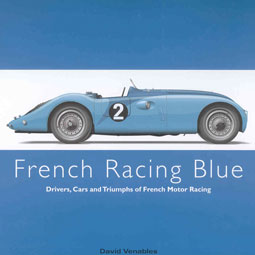
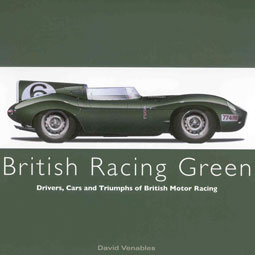
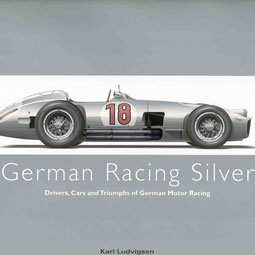
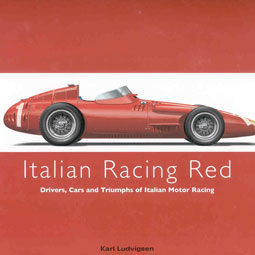
We have previously reviewed “Italian Racing Red” but now with the addition of “British Racing Green”, “French Racing Blue” and “German Racing Silver”, publisher Ian Allan has given us a general, relatively complete, and eminently competent view of motorsport history, country by country.
It may seem that such books are unnecessary given the general depth of knowledge we know our readers (and the Internet) possess. As a group, we probably have a difficult time imagining that others don’t have this background that many of us take for granted. This does not infer superiority by any means but more generally, age and/or obsession. Whatever the case, there exists a need for such books to be published and the “Color” series is a new, up-to-date and well-done take on the subject of motor racing in the twentieth century.
 Steven Cavalieri’s rendition of the 1907 Opel Kaiserpreis Racer.
Steven Cavalieri’s rendition of the 1907 Opel Kaiserpreis Racer.
The books are interesting and competent due to the tremendous depth of authors Karl Ludvigsen and historian David Venables. Conceived “to introduce the readers to the cars, circuits, companies and characters” of the four nations which dominated international motor racing, they are far more than that. Neither too tedious nor too light, with each volume this reviewer learned a few things not previously known to him. And for those of us who immerse ourselves perhaps too deeply into our favorite but limited-in-scope topics, the books remind us that there is more on heaven and earth than just the blue of the French and red of the Italians.
 The Fiat 804 of 1922. Its engine would set the standards for a generation of Grand Prix cars from both France and Great Britain. Art by Steven Cavalieri.
The Fiat 804 of 1922. Its engine would set the standards for a generation of Grand Prix cars from both France and Great Britain. Art by Steven Cavalieri.
As in the previous “Italian Racing Red”, Ludvigsen brings to bear his tremendous library and research skills to present “German Racing Silver”, in which he immediately takes pains to correct his mistake; of course it should be German Racing White. Ludvigsen tells us that the Silver Arrows came about not because the Mercedes team stripped off the paint to save weight for the 1934 750 kg formula, but that the phrase was attributed to a radio reporter, Paul Laven, who described the unpainted SSK streamliner of Manfred von Brauchtich as a “Silberne Pfeil”, or silvery arrow some two years before the onset of the 750kg Grand Prix car. BWM returned to white as the primary hue on its 2000 F1 cars, as did Porsche with the Carrera 6 in 1966. A master in German history, Ludvisgen brings us from the Otto cycle to Audi domination at Le Mans, and the return of Mercedes Benz to the Formula 1 circuits.
Venables, the author of “The Racing Fifteen-Hundreds” and the “First Among Champions: The Alfa Romeo Grand Prix Cars”, also has a well stocked arsenal for his volumes “French Racing Blue” and “British Racing Green”. Unlike the Germans and French, the Brits couldn’t quite get their coloring book together until after the Great War. Until then, a British car may have been green, maybe red, blue with red, or just about any color. After the war green was the definitive color (the British spelling is colour, but we keyboard in the U.S.) but even then it could be any shade of green so long as it was green. What we think of as British racing green is more of a sales option color chip than a legendary race hue.
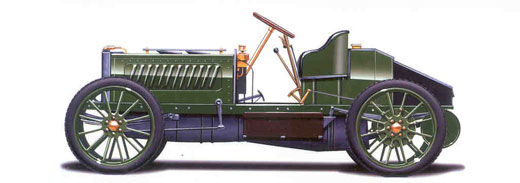 The British D50 Napier of 1902 won the Gordon Bennett race in 1902 driven by S.F. Edge. Art by Steven Anderson.
The British D50 Napier of 1902 won the Gordon Bennett race in 1902 driven by S.F. Edge. Art by Steven Anderson.
For all their dominance in recent years, it is interesting that for a period of thirty three years, no British car would win a major Grand Prix. Venables takes us through the initial success of the Napiers and their record cars, and onto Sunbeam and the Sunbeam-Talbot-Darracq years, when, in 1923 and 1924, Sunbeams won a number of Grand Prix races with the Becchia/Betrarione designed cars, and continued this with a superb six cylinder sports racing car. Finally, in 1957 Vanwall won the British Grand Prix and re-established the primacy of British Racing Green. In betwixt, Bentley, MG, ERA, Aston Martin, Jaguar and BRM fill the pages of the green book, which Venables does well and with admirable enthusiasm.
 The 1912 L76 Peugeot which employed an advanced DOHC engine and established engine design for the remainder of the 20th century. Art by Steven Cavalieri.
The 1912 L76 Peugeot which employed an advanced DOHC engine and established engine design for the remainder of the 20th century. Art by Steven Cavalieri.
Turning his attention toward the French, Venables take us on a spin through the turn of the century French domination, with Panhard, Mors, and Renault battling it out on dusty country roads. Like all four books the text is interesting, and the layout provides a feast for the eyes and mind. Fortunately, Venables does not over-Bugatti us, and if anything the role of the Molsheim magician is subdued, surrounded by Lorraine Dietrich, Ballots, Peugeots, Voisins and Delahayes. The post war era is well covered, from Gordini to Matra and Peugeot to the latest Renault Formula 1 and the 2008 season.
The four volumes share the same size and roughly the same number of pages (175) and are all hardback covers with attractive and matching dustcovers. All have superb drawings by Steven Anderson in the British volume, and Steven Cavalieri for the other three. The style is similar, and all books have a clear, visually interesting layout, sprinkled with relevant sidebars, diagrams, maps and of course both color and black and white photos. Drivers, designers, builders, tracks and record venues are all part of the overall theme included with each book. There is a very complete index, bibliography and table of contents. The volumes lack a comprehensive list of victories or podium finishes but given the broad scope, it would have been far too much to ask of what are basic books on the subject. The four books beg to be sold as a set, with an attractive slipcover, but that does not yet appear to be in the offing. A welcome addition to the library separately or as a very effective combination.
Italian Racing Red, British Racing Green, French Racing Blue, German Racing Silver
By Karl Ludvigsen and David Venables
Ian Allan Publishing Ltd. Hershan, Surrey, Great Britian 2008
176 pages, 150 color and B&W photography, Hardback
$46.95 USD each
Order from: www.Ianallanpublishing.com